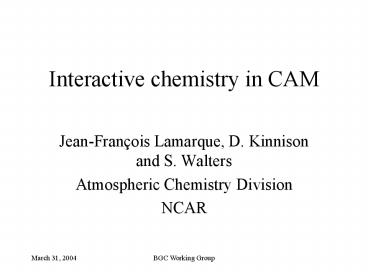Interactive chemistry in CAM - PowerPoint PPT Presentation
1 / 15
Title:
Interactive chemistry in CAM
Description:
Photolysis and chemical reactions solved with an implicit/explicit set of solvers. Lookup table photolysis rates, including cloud correction (but not aerosols) ... – PowerPoint PPT presentation
Number of Views:43
Avg rating:3.0/5.0
Title: Interactive chemistry in CAM
1
Interactive chemistry in CAM
- Jean-François Lamarque, D. Kinnison and S.
Walters - Atmospheric Chemistry Division
- NCAR
2
Goal
- Provide a flexible framework for the study of
chemistry-climate interactions in CCSM, including
land/ocean interactions - Include gas-phase and aerosols
- Focus on the troposphere and stratosphere
3
Computational approach
- Chemical scheme is input in a preprocessor that
creates a set of subroutines added to the
standard CAM - Reads a set of external files (for emissions,
deposition velocities and photolysis rates) - Uses the finite volume dynamical core for the
advection of tracers - Convective and diffusive transport of tracers is
considered
4
Main features
- Photolysis and chemical reactions solved with an
implicit/explicit set of solvers - Lookup table photolysis rates, including cloud
correction (but not aerosols) - Wet (first-order loss linked to precipitation in
CAM) and dry removal - Surface emissions (fixed, monthly averages)
- Lightning NO production linked to convection in
CAM
5
Current status
- Implementation in WACCM of combined tropospheric
(regional and global scale) and stratospheric
chemistry (including PSCs) 105 species, over
300 chemical reactions - Simulations performed with 52 levels, extending
up to 85 km. - Stratosphere-troposphere flux is explicitly
calculated - Horizontal resolution of 2x2.5
- 25 years of present-day simulations, using fixed
SST
6
Performance
- In the present configuration, inclusion of
chemistry (including transport of tracers)
approximately doubles the cost of the equivalent
WACCM simulation this ratio will be a little
worse for CAM - On bluesky, 96 CPUs, 1 year in 2 days
7
Mid-tropospheric ozone
8
Model evaluation
- Comparison with tropospheric and stratospheric
observations - Comparison with TOMS total ozone column
9
Comparison with observations (1)
Red model results Blue observations
Barrow, Alaska
Black sea, Romania
Mauna Loa, Hawaii
Halley station, Antarctica
Month
10
Comparison with observations (2)
Ozone mixing ration (ppbv)
Month
11
Comparison with observations (3)
NOx NO NO2
12
Comparison with observations (4)
13
Summary
- Working version of interactive tropospheric/strato
spheric chemistry - Analysis of results indicate a good overall
representation of the chemistry in the atmosphere - Biases are similar to the ones found in MOZART
results, on which the chemistry is based
14
Next steps (1)
- Develop a CAM version (requires the addition of
upper-boundary conditions) expected to happen
within a month - Inclusion of aerosols (ammonium, sulfate,
sea-salt, dust,organic and black carbon X.X.
Tie, P. Hess N. Mahowald and P. Rasch) - Better representation of wet removal (P. Hess and
P. Rasch) - Interactions with CLM (deposition emissions of
BVOCs (C. Wiedinmyer and S. Levis) soil NO)
15
Next steps (2)
- Interactive calculation of photolysis rates
- Development of a variety of chemical packages for
ease of use - Coupling with ocean biogeochemistry
- Coupling between the nitrogen and the carbon
cycle through CLM (P. Thornton) - Interactive emissions from wetlands































